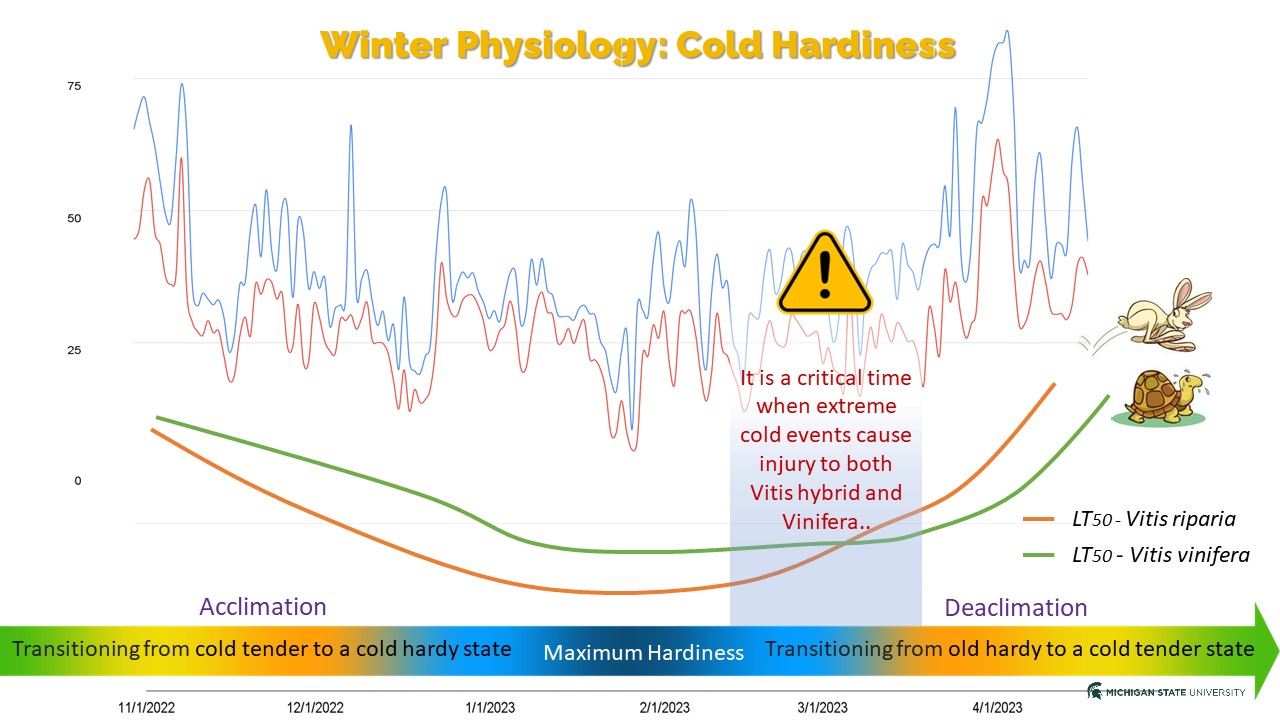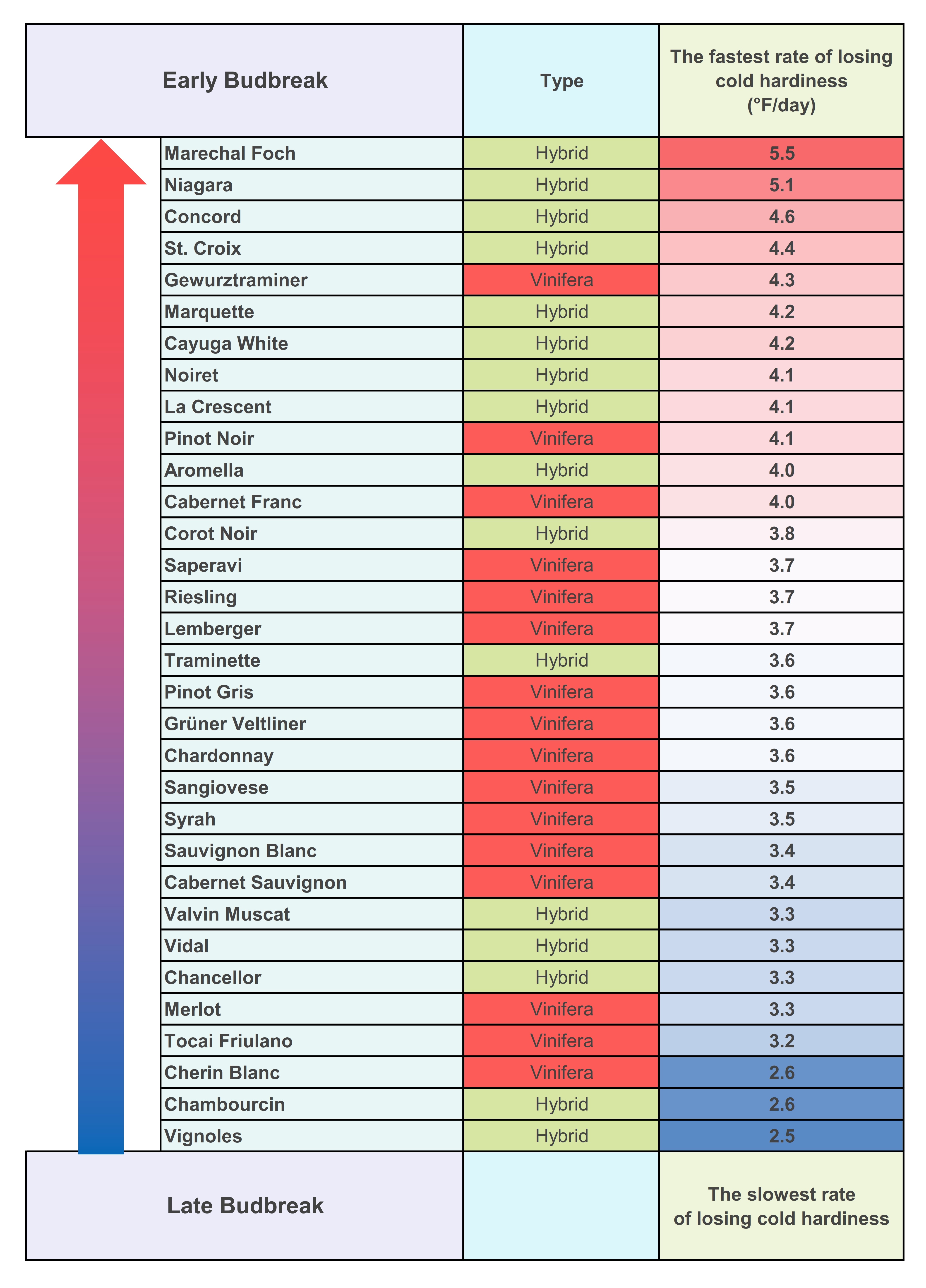Michigan grape growers should prepare for potential late winter freeze and early spring frost risks
Michigan's warming winters bring earlier budbreak in grapevines. This can be beneficial for growth but increases the risk of spring frost damage. Ensure vineyard success in this changing climate by understanding dormancy and implementing frost protection.

Warming winters pose a growing threat to Michigan vineyards. Milder temperatures disrupt the natural dormancy cycle of grapevines, causing them to lose cold hardiness earlier than usual and become more vulnerable to late-season cold events. Mild winters also cause early budbreak, which can lead to devastating damage from spring frosts, significantly impacting grape yields. To ensure vineyard success in this changing climate, understanding grapevine dormancy and vulnerability during budbreak is critical.
Michigan grape growers need to be equipped with effective strategies to assess and adapt to cold damage, employing both passive and active frost protection measures. By implementing these strategies, growers can mitigate risks and ensure their vineyards continue to thrive.
Winter dormant physiology
During the winter dormant period, grapevines undergo a process called cold acclimation, which increases their tolerance to freezing temperatures. This process involves changes in the chemical composition of the plant tissues, such as the accumulation of cryoprotectant compounds like soluble sugars and proteins. These compounds help lower the freezing point of water within the plant cells and stabilize cell membranes, enabling the vines to withstand colder temperatures without sustaining significant damage.
Additionally, dormant buds are thought to be disconnected or weakly connected to the vine's vascular system, which limits their potential to take up water and reduces the risk of ice crystal formation within the bud tissues. This natural adaptation allows dormant buds to survive extreme cold temperatures during the winter months.
It's important to note that the level of cold hardiness can vary depending on factors such as cultivar, rootstock, growing season biotic and abiotic stress like diseases and over or under cropping and environmental conditions. Regular monitoring of bud cold hardiness levels through techniques like differential thermal analysis can help growers assess the potential risk of freeze damage and make informed decisions about implementing protection strategies.
Understanding winter injury and frost damage
There's a distinction between frost and freeze damage on grapevines. While frost simply refers to air temperatures dipping below freezing (32 degrees Fahrenheit or 0 degrees Celsius), freeze damage occurs when ice crystals form within the plant tissues themselves. This internal ice formation disrupts cellular function and causes dehydration, ultimately harming the vine.
Late winter cold snaps can injure dormant buds of both hybrid and vinifera grapes, especially if they've lost their winter hardiness. Early spring frosts, on the other hand, pose a threat to tender green shoots and young leaves, potentially leading to significant yield losses.
Notably, Vitis hybrid grapes are more attuned to environmental changes. They lose their cold hardiness and start to grow faster than most Vitis vinifera varieties, making them more susceptible to cold and frost damage during fluctuating late winter temperatures (Figure 1).

Grapevine cold damage assessment
Assessing grapevine cold damage before pruning is crucial for vineyard management to minimize yield losses and maintain vine health. Cold temperatures during dormancy can harm grapevines, leading to bud mortality and reduced productivity. Managers evaluate damage by inspecting buds and canes for necrosis, discoloration and desiccation, and may use techniques like bud dissection or survival counts. This proactive approach informs decisions on pruning severity and potential replanting to sustain the vineyard and optimize grape quality and yield. (Read more in “Freezing stress, cold hardiness and managing winter damaged vines” from Michigan State University Extension.)
Adapting pruning practices to bud mortality levels in grapevines
Pruning strategies are based on varying levels of bud mortality in grapevines. For bud mortalities ranging from 10% to 15%, no adjustments to the standard winter pruning are necessary. However, when bud mortality increases from 20% to 50%, it is advisable to leave a higher number of buds, around 20% to 30% more, during winter pruning. This involves pruning four to five bud spurs instead of the typical two to three and leaving more spurs or canes per vine.
In cases where bud mortality reaches 60%, it is recommended to double the number of buds compared to the standard pruning strategy. Finally, if bud mortality exceeds 60%, either no dormant pruning is conducted, or the focus is solely on reestablishing the vine's bearing structure. When bud mortality is over 70%, pruning effort should be directed to reestablish the fruit-bearing zone of the vines and to balance the growth of the vines during spring and summer.
Grapevine frost damage
Grapevine frost damage presents significant challenges for cool climate grape growers, especially after a mild winter that buds push earlier than usual. Frost can harm grapevines at various growth stages, from bud break to flowering and fruit development. When temperatures drop below freezing, frost can injure tender grapevine tissues, resulting in reduced yields and compromised grape quality. This can even impact the next-year pruning strategy to return the affected vine to maximum productivity.
Budbreak, a crucial grapevine growth stage, exposes tender shoots to frost damage. Vulnerable due to their lack of protective structures and transition from dormancy, buds face risks in Michigan's variable spring weather. Therefore, Michigan grape growers must be vigilant during this period, implementing frost mitigation strategies to minimize the potential for frost injury and ensure the success of their vineyards.
Understanding frost types in grape growing regions
Advective frost: This type of frost is a widespread weather phenomenon characterized by strong, cold winds that sweep into a region during the day and/or night, bringing temperatures colder than the critical threshold. The rapid movement of cold air strips away the heat from plants, leading to freezing damage. Unfortunately, protective measures like wind machines are ineffective against advective frosts, leaving little recourse for growers to mitigate damage.
Radiation or radiative frost: Common in many grape-growing areas, radiation frost occurs when a dry, cold air mass settles over an area with minimal cloud cover and wind at night. During this type of frost, plants and soil, being warmer than the surrounding air, radiate heat outward, causing them to cool more rapidly than the air. Fortunately, radiation frost is easier to protect against compared to advective frost, allowing growers to employ preventive measures to safeguard their crops.
Passive strategies: Minimizing frost damage risks
Strategic site selection: Choosing a vineyard site with optimal air drainage is paramount. Mid-slope locations with minimal obstacles to cold air flow are ideal, as cold air tends to settle in low-lying areas. Thorough evaluation of historic temperature records, slope, aspect and elevation should guide site selection.
Cultivar optimization: Planting grapevine cultivars with delayed bud break can mitigate the risks associated with early spring frost events. Growers should prioritize cultivars known for their later bud break in areas within the vineyard that are more susceptible to frost (Table 1).
Prudent training system selection: Choosing a training system that positions buds higher on the trellis can reduce frost hazards. As a general rule, the frost risk decreases by approximately 0.36 C (0.65 F) for every 10 centimeters (3.94 inches) of height above the soil level.
Strategic pruning practices: Delaying pruning can help avoid accelerating bud break, while double pruning techniques can further delay bud break, providing an extended window for frost protection.
Delaying bud break chemically: Judicious application of vegetable-based oils at non-toxic rates can delay bud break by two to 20 days, depending on factors like cultivar and coverage, offering an additional layer of frost protection.
Optimized middle-row management: Maintaining short ground cover can increase soil warming during the day, leading to enhanced heat release at night, which may provide some frost protection.

Active frost protection measures
Wind machines: These machines blend warmer air from above the inversion layer with cooler air near the vines, potentially raising temperatures by 1–3 F (0.6–1.7 C).
Over-vine irrigation systems: Sprinklers create an insulating layer of ice around buds and shoots, harnessing the heat released during freezing to shield the vines.
Plant-based dispersions: Plant-based dispersions, comprising cellulose nanocrystals and nanofibrils, demonstrate remarkable effectiveness in reducing frost damage across various crops, including grapes, sweet cherries and apples. Applying plant-based dispersions can enhance crop resistance to frost by over 5 F, offering promising solutions for growers to explore during upcoming winter and spring seasons.
LALSTIM OSMO: A highly soluble product containing 97% natural Glycine Betaine, an essential amino acid, LALSTIM OSMO, penetrates plant tissues to stabilize membranes and cellular proteins. Acting as a potent osmoprotectant, it is rapidly absorbed and distributed throughout the plant within 24 hours, remaining active at the cellular level for two to four weeks. It facilitates water uptake and retention, adjusts osmotic balance and enhances photosynthesis, nitrogen metabolism and translocation, aiding plants during environmental stresses such as heat, cold, frost, drought and salinity.
As Michigan grape growers brace themselves for the challenges of late winter freezes and early spring frosts, it's imperative to adopt proactive measures to safeguard vineyards and ensure fruitful harvests. Understanding the intricate dynamics of winter dormancy, frost types and grapevine physiology equips growers with the knowledge necessary to mitigate risks effectively.
Using active frost protection measures such as wind machines, over-vine irrigation systems and innovative solutions like plant-based dispersions and LALSTIM OSMO offers promising avenues to bolster crop resilience against frost damage. Additionally, prudent passive strategies including strategic site selection, cultivar optimization and strategic pruning practices play pivotal roles in minimizing frost risks.
By integrating a combination of active and passive strategies tailored to your specific vineyard conditions, you can navigate the uncertainties of late winter and early spring with confidence, ensuring the longevity and prosperity of your vineyards in the face of frost-related challenges.



 Print
Print Email
Email